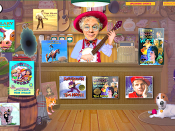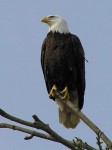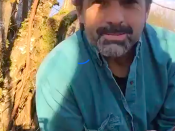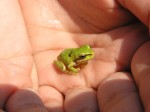
This article is being published in honor of the 2014 Great Backyard Bird Count. Check out its great video instructions and online submissions tool.
Identifying Birds by Sound & Behavior
<
If you’re not already excited by birds and bird voices, check out my previous article on bird language which will teach you when predators are lurking around, when birds are mating, when chicks have hatched, where the exact edges of their territories lie, and so much more.
Fortunately, recognition of bird calls nowadays is as easy as going to the online Cornell Lab of Ornithology or using some of the great apps where you can find most bird songs and calls. But it can be overwhelming. What I recommend is to listen to their recordings of vocalizations for the American Robin or any bird you are familiar with. They’ll tell you if what you are hearing is a chick begging or a bird’s song, and it won’t take you long to guess whether the “calls” they recorded might have been alarms, aggression or companion calls.
In fact, it is only necessary to learn the vocalizations of 3 birds. I recommend 1) a “under-brush” feeder, such as a sparrow to tell you what’s happening on the ground, 2) the American Robin to tell you what’s happening in the lower half of the trees, and 3) a water-loving bird such as the red-wing blackbird, or mallard duck to tell you what’s happening around the water. After that, learn one raptor, one colorful (tree-top) song bird, and another bird that covers a new part of your landscape that can teach you something.

There are also some other general tricks to know. For instance, if you hear a bird singing near your house – at long length – with a fast, varied song, then you probably have a house finch. It will visit your sunflower feeder. Visually, they are hard to distinguish from purple finches and cassin’s finches, but again, if it’s around your house and at your feeder, it’s probably a house finch. There is no other yard bird in our area that has such a long, fast and varied song.
How about this. If you hear a bird change from singing, to giving a chirp-like call, then it’s probably a companion or alarm call. Listen, experience, and create your own knowledge in addition to using field guides. Just go outside, find a robin, and follow it around. It’s amazing how few people can recognize a robin’s song, one of the most beautiful in nature: a slow, melodic whistle that lasts a very few seconds. Within a few minutes outside, you will be whistling along with it.
Day in the Life of a Nesting Song Bird (varies by species; this is just an example)
Dawn Chorus, Eat
Sing Extensively Around Boundaries of Territory, Eat
Sing Briefly Around Boundaries of Territory
Siesta from 11:00-1:00 Standard Time
Sing Briefly Around Boundaries of Territory, Eat
Sing Extensively Around Boundaries of Territory, Eat
Call in the Evening to Roost
Quick Visual ID – Setting Up Feeders Correctly & Other Tricks

If you can’t recognize any bird from another, or if you want to learn more, the absolute best way is to set up bird feeders in front of your kitchen window or another location you regularly view. However, it is critical that you place the feeder where birds can see cats and other dangers approach, and that you carefully wash your feeder every time the seeds run out in order to reduce disease transmission between birds. There are other concerns people have with bird feeders, but I believe that the benefits to you and the birds outweigh any negatives.
There are four feeders you will want. All of them are available at any “big box” or birding store. First, buy a plastic feeder (easy to clean and they come with rain-proof covers) along with black sunflower seeds. Don’t bother with seed mixes, as they produce a lot of waste because the birds really just love the sunflower seeds, and waste attracts vermin like rats.

The sunflower seed feeder will be all you need if you are just starting. It’s the one that attracts the greatest variety of birds. Robins don’t visit feeders, though, as they need open, wormy ground to feed. To attract birds that don’t visit feeders, you need to develop habitat for them. As a rule of thumb, for every new plant species you add to your yard or balcony, you attract one new bird. If you want to attract robins, just open up some dirt, water it, and if you don’t notice any worms in there within 24 hours, go gather some to add.
The second feeder you will want to consider is a “suet feeder” along with some suet packages, of course. This will attract woodpeckers, bushtits, jays, and a variety of other birds. Bring it inside at night if you start noticing rodent chew marks on it. The third feeder I recommend is a “finch feeder” along with thistle seeds which should be sold right next to it. This will attract goldfinches and a couple other birds that can feed upside-down.
Finally, it’s great to have a hummingbird feeder, but don’t buy the colored water they sell at stores. Just buy some organic cane sugar, heat some water, melt the sugar into it, cool and fill the feeder.Again, let these feeders get used up, then clean them every time you refill.
Here’s another trick to get close to birds. Pretend like you’re foraging on plants, and turn yourself sideways as you inch closer to a bird, because standing tall, and showing your chest, are threats to birds.
Using Your Field Guide for Positive Bird Identification

We’re going to step right in and learn the easiest way to study those birds! To make this article more fun, it will be helpful if you can find a bird field guide and turn to the index in back, or open a new window on your computer screen and check out the awesome Cornell Lab of Ornithology list of birds which you can order taxonomically or alphabetically by common and scientific name.
However, it’s still critical to own a bird field guide to identify birds by sight in the field. The easiest book for beginners to use is Birds of North America: A Guide to Field Identification which is a Golden Field Guide from St. Martin’s Press. It’s cheap, comprehensive for everyone no matter your location, and easy to carry in a pocket. Get the most recent edition since bird names and territorial boundaries are constantly changing.
For intermediate birders, I recommend the Sibley Field Guide to Birds (of Western or Eastern North America depending on your location), or the Peterson Field Guide to Birds (Western or Eastern) only if it’s the 2010 or later edition since before that, they didn’t include range maps next to each bird. National Geographic, Smithsonian, or Kaufman’s are also great field guides, so if you already have one of those, then you’re set.
For advanced birders, I recommend getting the Birder’s Handbook which is a great desktop book for learning bird habits, plus Bird Tracks of North America by Mark Elbroch & Marks, Bird Feathers by Scott & MacFarland, Kaufman’s Guide to Advanced Birding plus a couple of the field guides to bird eggs and nests, and having a copy of each of the normal field guides which is important for advanced birders to distinguish between similar species such as certain sparrows, warblers, gulls and other challenging groups.
 John James Audubon is 227
John James Audubon is 227
Let me go on a very important tangent related to all those great field guides to birds by mentioning John James Audubon who would have been 227 years old this year. He was the son of a Haitian ranch owner and one of his father’s many mistresses, but John’s father supported him as his own through trial and tribulation, including his love for drawing birds. John developed the first comprehensive field guide to birds of North America despite heartbreaking setbacks, and my wife Kim and I consider him an idol. We even spent part of our honeymoon at the Audubon Nature Institute in New Orleans.
All of the great birding field guides have built upon that first Audubon collection. In fact, one of the original printings of his field guide sold recently at Sotheby’s for over $12 million, the highest price ever garnered for a book. Unfortunately, modern Audubon field guides have been very challenging to use before they came out with a new edition a couple years ago that was wonderful, but big, pricy and hard to find.
The Audubon editions printed in the 1900s use photographs instead of art depictions which make it challenging to identify certain birds because photos only capture a portion of what you need to see, while art depictions emphasize what you need to focus on for identification. If you have one of those older Audubon field guides, you should consider getting one of the others I recommend above.
Easy Way to ID Birds
I think it’s difficult to go on a bird walk and try to identify whatever bird happens to cross your path. What you need first is context. So, before you go outside, pick up your field guide, or click into the taxonomy section of Cornell Ornithology website, and follow these steps:

1. First Half of Book – Loons-Grebes-Cormorants: Look at the first bird in the book. Field guides are ordered taxonomically, which is just how birds are related to one another based on evolution. Usually, the loon is listed first because it is considered the oldest non-extinct bird species. You’ll find loons nesting on lakes in the summer, and floating out on salt water in the winter. Turn the page and notice that the Grebes are usually the next set of birds listed in your book, because they are closely related to loons. Keep turning the pages until you hit the Cormorants. Okay, with these 3 bird families, you have a set of birds that are very similar to one another to keep in mind next time you see something a bit bigger than a normal duck floating out there in the water, and all you’ll have to do is look at the beginning of your field guide to check out the loons, grebes and cormorants.
2. First Half of Book – Big Wading Birds: Keep turning pages, ignoring everything until you start seeing the big, wading (rather than floating) birds with common names that include heron, egret, bittern, ibis, spoonbill and stork. Unfortunately, now we hit the first exception to the rule of like-birds being obviously listed with like-birds, as vultures and condors are in the same family, so just keep that exception in mind for when you get to the intermediate level of birding.
3. First Half of Book – Geese-Swans-Dabbling Ducks: Next come all the other floating birds, including geese, swans and ducks. There are 2 things you’ll want to remember now. One is simply where these birds generally are in your field guide so that they are easy to find when you want to identify one of them in the field. The other thing you’ll want to do is to ignore all of the diving ducks because they are hard to identify at the beginner level. Just learn the surface-feeding or “dabbling” ducks that you find in wild areas of your area. Don’t try to identify these in city duck ponds, however, as they often interbreed and make it impossible to identify one from another.
4. First Half of Book – Daytime Raptors: Remember that exception to the “wading birds” rule, where vultures and condors are listed? At the intermediate level of birding, you’ll begin to distinguish them from the next set of birds in your field guide, which are the diurnal (daytime) raptors, known generally as hawks but are broken down into families that include Buteos (big hawks and eagles), Accepitors (mostly bird-hunting forest hawks), and Falcons (bird-hunters in open areas).
5. First Half of Book – Game Birds: I’d like to tell you that nocturnal raptors are listed next in your field guide, but they’re not closely related to the diurnal raptors. After the diurnal raptors come the “gallinaceous” or “upland game” birds like grouse and pheasant.

6. First Half of Book – Little Shore Birds, Gulls & Terns: I highly recommend that you skip through the Rails because they are hard to see, the Cranes because they are usually just passing through unless you are far north or far south, and the Gulls because they are so difficult to distinguish from one another. The one thing you do want to learn is how to distinguish a Tern from a Gull, however. So check out the Terns and find out if any are local to your area. Also, all the little shore birds (sandpipers, plovers) are really hard to distinguish from one another. I recommend learning just one of them. The most common one throughout the country is the Killdear, and so if you ever see a medium-sized bird running along the ground in a sandy/gravelly area and not flying too far away from you, that’s probably a killdear. If you look at it in your binoculars, you’ll know because if it’s striking facial features.
7. Small Families in the Middle of the Book – Doves & Pigeons, Parrots & Cuckoos: Skip past the Murres and Auklets, as they are usually pretty far out on the salt water. However, you might be able to identify your local Puffin, for instance, so if you are on a boat, keep that in mind. Otherwise, keep turning the pages and you’ll find a bunch of small families of birds. The first are the Doves & Pigeons. Not a lot of them, so just look at the range map and see which ones are in your area. You might be surprised to find out that there are a couple of wild, native pigeons that stay deep in the forest, so it’s really a fascinating family. Next are the parrots and cuckoos, and if you live north of the tropics, it should be easy to identify the few you might have near you.

8. Small Families in the Middle of the Book – Nighttime Birds: Next you’ll find the nighttime birds, including Owls & Goatsuckers. Look at the range maps of the owls, and make a list of the ones that live in your area. Then either get a subscription go to the free section of the Cornell Lab of Ornithology websites to hear the surprising sounds of owls of your area so that you can identify them at night. The other nighttime birds you’ll want to know are the Goatsuckers, including the Nighthawk & Poor-Wills. Those are also birds you’ll want to listen to the sounds of, as well as whose ground camouflage and flight patterns will blow your mind!
9. Small Families in the Middle of the Book – Swifts & Hummingbirds: The next “small family” of birds in the middle of your book should be the swifts and hummingbirds. They don’t look like they’re related to one another, but you can’t argue with DNA! Again, look at the range maps to find out which hummingbirds are in your area, and do the same for swifts, although they are hard to identify because they look a lot like swallows and they never sit still!
10. Small Families in the Middle of the Book – Kingfishers & Woodpeckers: The last “small families” in the middle of your book should be the kingfishers and woodpeckers. Check out the kingfisher(s) that live in your area, as they will become easy to identify by sound, if not sight. The make a list of the woodpeckers in your area, and learn just the ones that seem to be unique by coloration or size. For instance, if you have the Piliated Woodpecker in your area, nothing matches its size. Or if you have sapsuckers in your area, other woodpeckers can’t compare to their fully-red heads.
11. Last Half of Book – Song Birds: Passerines, also called perching birds or song birds, are commonly seen but they really get confusing due to the overwhelming number of birds in this family, which takes up the last half of your field guide. So just go back to the second article in this series and set up the right bird feeders to start learning the 5 most common passerines that visit your feeder, and if you want to continue to the intermediate level of birding, check out my bird taxonomy chart where I divide the passerines into:

a. sub-oscines (flycatchers, including phoebes and kingbirds)
b. shrikes and vireos
c. corvids (jays, crows, ravens, magpies)
d. high flyhawkers (swallows)
e. tree-gleaners (horned lark, tits, chickadees, nuthatches and creeper)
f. niche underbrush feeders (wrens, dipper)
g. kinglets (and gnatcatchers)
h. thrushes (bluebirds, solitaire, robins, veery)
i. mimics (including thrashers)
j. unique families (pipit, waxwing, starling)
k. warblers (including yellowthroat and chat)
l. stout singers (tanagers, cardinals, buntings, grosbeaks)
m. general underbrush feeders (towhees, sparrows and juncos)
n. icterids (orioles, meadowlarks, blackbirds, grackles, cowbirds)
o. finches (including redpolls and grosbeaks)
Enjoy the Birds!
Learning your birds doesn’t have to be a daunting task. Just take 30 minutes to open your book and learn how it’s put together. Then outside, the birds will reveal themselves!
Article author Chris Chisholm is founder and co-owner of Wolf Camp and the Wolf College. If you would like to practice these skills with Chris and other staff instructors, join any of our April Wildlife Classes, Day-Before-Mothers-Day Birding Workshop, and summer Tracking Wolf Country: Birds to Big Critters expedition or simultaneous youth camp.










